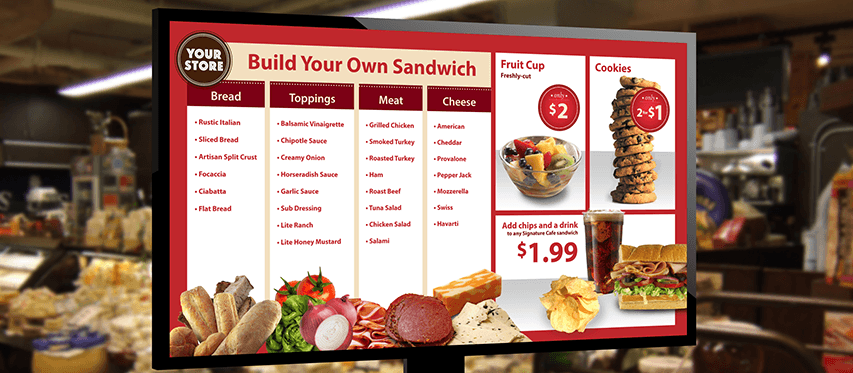5 Major Developments in the History of Digital Signage

To celebrate 50 years of Hughes innovation and leadership this year, we have been posting a “5 for 50” series that shares personal insights from Hughes executives on all things related to technology and trends. Here are 5 major developments in the history of digital signage.
-
1990 – 1995: Not just for bars anymore! Early digital signage deployments were often simply mounted TVs on the walls of bars. Then, high end retailers realized they could use them for more engaging visuals to add ambiance and improve the in-store experience. The cost of signage was considered an expense similar to lighting or other fixtures. But screen pricing hindered mainstream adoption and the required computer technology and content management systems were cumbersome to adopt and maintain. Typical deployments were limited to large and expensive video walls in big venues, such as casinos, airports, and stadiums.
-
1995 – 2000: Can ad revenue offset costs? To offset the high costs of screens and content management, companies created revenue sharing models to sell advertising on screens, similar to running TV commercials. These new ad networks served as a way to monetize digital displays. The approach was most effective when products and services featured in ads were relevant to the host venue’s customers. For example, an airport might display ads for various travel destinations or business technology, whereas a department store might run promotions for specific skincare products or fashion labels.
-
2000 – 2010: Going paperless. As businesses launched environmental and cost initiatives and focused on reducing the use and expense of paper, especially for posters and flyers in retail settings, digital screens offered an ideal replacement option. The use of digital screens increased message flexibility and variety, and better supported compliance-related or time-sensitive initiatives. For retailers, compliance meant getting the marketing materials to the right place in the store at the right time. Since busy store personnel were responsible for putting up and refreshing posters, the industry average for compliance with paper-based materials was less than 60%. But even with these compliance issues reducing the impact of store promotions, the screen price was still too high for widespread use. As High-Definition TVs became more common and the ROI for digital signage improved, industry groups like the Digital Signage Federation formed, and events like the Digital Signage Expo were held to help raise awareness.
-
2010 – 2015: The ROI debate. As businesses debated the ROI of customer-facing digital signage and its impact on purchase behavior, the positive ROI was clear when it came to employee-facing communications and engagement. Savvy employers recognized the value of the breakroom to create an optimal work environment, foster corporate culture and increase productivity. In addition, employee-facing digital signage solutions provided a common platform for delivering employee training and onboarding material. By 2012, Breakroom TV—a platform that combined informational content, commercial television programs, and training—was born.
-
2016 – Present: Falling prices and SmartTVs drive adoption. Screen prices finally dropped and SmartTVs with integrated Wi-Fi hit the market, eliminating the need for a separate digital media player or complex wiring. With the masses now accustomed to digital displays and video on demand capabilities, digital signage took off. The emergence of cloud-based content management systems further simplified and accelerated adoption by more types of enterprises, including grocers, restaurants and healthcare clinics.
With more advancements on the horizon, digital signage solutions will likely soon incorporate mobile deployments, greater interactivity like immersive augmented and virtual reality presentations, artificial intelligence and data analytics for refined segmentation, targeting and content delivery. So, keep an eye out for digital signage at your favorite businesses, the next screen you encounter may be speaking directly to you!